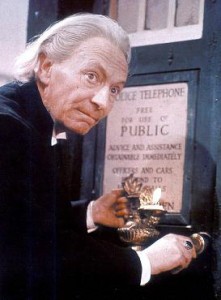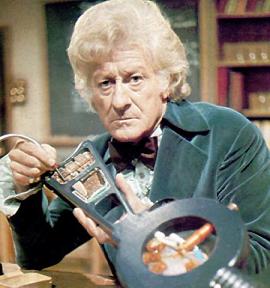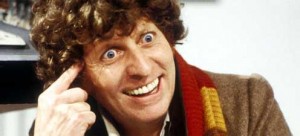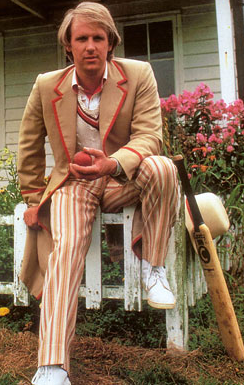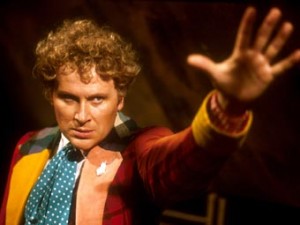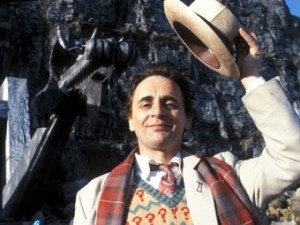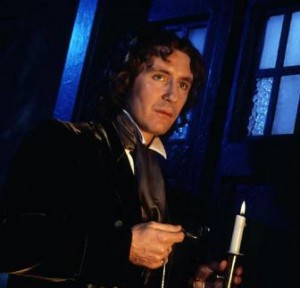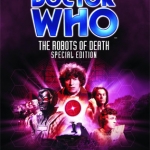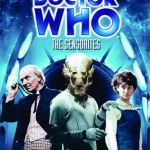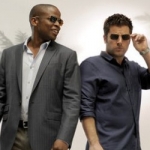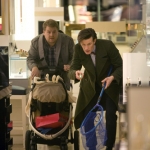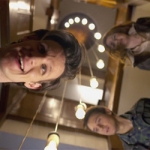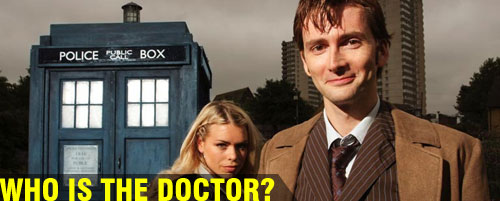
The second part of Fandomania’s 45th Anniversary tribute to Doctor Who takes a look at all the incarnations of the Doctor. Since Doctor Who materialized onto our television screens forty-five years ago, ten actors have played the role, and each of them has left his defining mark on the character. Let’s go down the list.
The First Doctor: William Hartnell (1963 to 1966)
When we first meet The Doctor, he’s an irascible, grandfather figure who finds himself biting off more than he can chew when he kidnaps his granddaughter’s schoolteachers, Ian Chesterton and Barbara Wright. The Doctor tries to distance himself from them, but eventually their human impulse for empathy becomes an endearment to The Doctor. Inevitably, The Doctor develops a mutual respect towards his companions, and soon towards humans in general. After Ian, Barbara, and his granddaughter, Susan, take their leave of The Doctor, he begins taking other human companions on board of his own volition. He soon finds himself eager to help wherever he is needed. One day, The Doctor ends up suffering one battle too many, and he collapses onto the TARDIS floor. The Nation’s laments were quickly curtailed when we suddenly were introduced to regeneration.
The Second Doctor: Patrick Troughton (1966 to 1969)
The Second Doctor was a polar opposite to his predecessor. This was a tradition that carried over to all the subsequent incarnations. Troughton decided to portray the character as a clownish, cosmic hobo, with a bit of a mischievous streak. His performance as The Doctor secured the show’s survival after Hartnell’s departure. The Second Doctor continued to cross swords (figuratively speaking) with enemies new and old, but soon he was put on trial by The Time Lords. In The Second Doctor’s final episode it is revealed that The Doctor’s lifestyle is not well regarded in Time Lord society. As a punishment for interference in the affairs of other planets, The Doctor was exiled on Earth in the 1970’s, with a new face.
The Third Doctor: Jon Pertwee (1970 to 1974)
“Play it as yourself” was the advice given to former comedy actor Jon Pertwee by his agent when he secured the role. The Third Doctor can easily be described as a hybrid of James Bond and Q. He favored vintage cars, gadgets, and scientific examination, and he has been known to neutralize his enemies with his exceptional skills in Venusian Aikido. During his exile, The Doctor found a home with U.N.I.T. (United Nations Intelligence Taskforce), a branch of the government formed to investigate paranormal activity around the world. After his exile was lifted, The Doctor decided to honor his commitment to U.N.I.T. until one day when he suffered severe radiation poisoning. After returning to Earth he regenerated once again.
The Fourth Doctor: Tom Baker (1974 to 1981)
With his curly locks, his floppy fedora hat, his wild eyes, and his wayyy too long scarf, Tom Baker became the quintessential Doctor to which all of his predecessors and successors are compared. With his unwavering charisma, Baker made the character a cult icon. Famously eccentric, Baker’s Doctor assumed a sort of Bohemian demeanor and returned to the life of a wanderer. It was during Baker’s era that we met the creator of true evil, Davros, the creator of the Daleks. The Fourth Doctor endured for seven years, traveling with spunky journalist Sarah Jane Smith, the savage Leela of the Sevateem, Time Lady Romanadveratrelundar, and a robot dog called K-9. Eventually, a run-in with The Doctor’s old nemesis The Master led The Fourth Doctor to fall from a radio telescope. Aided by an entity called “The Watcher,” The Doctor regenerated again.
The Fifth Doctor: Peter Davison (1982 to 1984)
Many were reluctant to fill Tom Baker’s shoes after his departure, and some were worried that the show would die with Baker’s Doctor. Then came All Creatures Great and Small actor Peter Davison. Davison bravely adopted the role and gave us a Doctor who was kindly, energetic, and above all the most human of all the Doctors. Davison’s performance was hands down the most accessible, giving audiences a Doctor they could relate to. He was endearing in his youthful enthusiasm and engaging in his selflessness. It was in fact this selflessness that led to one of the greatest swansongs any of the Doctors ever had when he opted to save his companion’s life rather than his own when they both contracted Spectrox Toxaemia, and there was only enough vaccine for one.
The Sixth Doctor: Colin Baker (1984 to 1986)
The regeneration had left The Doctor in a bit of a mess. His behavior was erratic and even violent. His fashion sense was questionable when he donned a multi-color patchwork coat, and his methods tended to be a bit unsavory. Colin Baker’s era was marred by a horrible curse commonly known as “Good Ideas, Bad Execution.” Many of the scripts were lackluster, and many characters were underdeveloped. At this point the BBC had daggers out for the series and attempted to take the show off the air. Luckily the fans rallied and saved the show from the chop. Alas, after one ambitiously satirical series dubbed “The Trial of a Time Lord” the producers unjustly blamed Colin Baker for the show’s declining standards and forced him to resign from the role. Colin Baker’s main regret was that he didn’t get to play The Doctor the way he wanted. Today, thanks to the Big Finish audio adventures, Colin Baker’s endeavors were honored when he was voted as the most popular Doctor on the Big Finish Adventures.
The Seventh Doctor: Sylvester McCoy (1987 to 1989)
The TARDIS is forced to crash land on the planet Lakertya, and the shock forces The Doctor to regenerate once more. After an uneven first series it was decided that changes needed to be made. McCoy’s Doctor was first and foremost a trickster and a manipulator who was famed for his powers of deception. All of this hinted that The Doctor was “far more than just another Time Lord.” Script Editor Andrew Cartmel strove to bring the show back to its enigmatic roots and to make The Doctor a figure of mystery again. Cartmel also took the time to innovate the Doctor/Companion dynamic by placing the companion’s history in the spotlight. Unfortunately, before Cartmel’s plans could come to fruition, the show was unceremoniously canceled. McCoy and his companion Ace are still a favorite amongst the hardcore fans.
The Eighth Doctor: Paul McGann (1996 to 2004)
The Seventh Doctor is forced to land on Earth in San Francisco 1999. He exits the TARDIS and winds up getting clipped in the crossfire of a gang war. The surgeons attempt to remedy The Doctor’s accelerated heartbeat (unaware that The Doctor has two hearts). The Seventh Doctor has a seizure and dies on the operating table, and he regenerates in the morgue a few hours later. After recovering from short term amnesia, The Eighth Doctor turns out to be a whimsical individual with a fondness for the simple joys of life. As it turns out, one of those joys happens to be fleeting kisses with his companions. Paul McGann’s era has always been a heated subject of debate between fans, despite the fact that the BBC openly adopted McGann’s solo effort as canon. Many puritanical fans deny its existence, but that didn’t stop The Eighth Doctor from living on with much success in the novels, comics, and of course the Big Finish audio adventures. The circumstances of The Eighth Doctor’s regeneration into The Ninth Doctor are still shrouded in mystery. The only thing that’s certain is that it happened in the heat of battle.
The Ninth Doctor: Christopher Eccleston (2005)
When we meet The Ninth Doctor in the beginning of the new series, we learn that he is a survivor of the last great Time War. He returns to Earth lost, alone, and struggling to press on. Then he meets Rose Tyler, a shopgirl whose eagerness to see new and amazing things matches The Doctor’s own, and through her, The Doctor regains his zest for life. When Rose is willing to sacrifice her life to save his, he returns the favor by saving hers, at the cost of his short-lived incarnation. Eccleston’s striking, intense performance aided Doctor Who in exploding back to life. Fans, young and old, flocked to the screens in droves. The new fans felt like they were discovering something new and amazing, while the older fans felt as if an old friend had returned. So it was a sad revelation that Eccleston announced that was only staying for one series. What fans didn’t realize is that something even bigger was on the horizon.
The Tenth Doctor: David Tennant (2005 to 2009)
When David Tennant emerged from the TARDIS doors on Christmas Day, the world was treated to a new brand of Doctor, one who elevated the character from being a cult icon to a status that had never been reached before… A POP ICON! Tennant injects The Doctor with his own singular joie de vivre, combined with his impressive range as a dramatic actor. Tennant even brings to the role a sort of pop culture sensibility, a sensibility which makes his Doctor reminiscent of a sci-fi geek who gets to live the ultimate fanboy dream. It’s clear he enjoys every minute of it. New Who fans were very cautious of Eccleston’s replacement, while old Who fans patiently waited and watched to see what Ten would offer. In the end, both sets were pleased to find a Doctor who created an appeal for a beloved character that reflected the heart and minds of the fans who watched it.
Recently Tennant announced his departure from the role after the conclusion of the 2009 Christmas special. Now it’s anyone’s guess as to who will take control of the TARDIS console next. What’s important is to remember how every single actor to play The Doctor has given the role his own signature style. At this point, all we can do is wait and see. Rest assured, the trip getting there will, without a doubt, be… fantastic.
Forty-five years down the road, Doctor Who is still one of the most versatile, spectacular, and most inventive programs on television. It’s a show for which the only limit is the imagination of those who make the series. In celebration of the forty-fifth anniversary, throughout the month of November we will be commemorating the best of Doctor Who‘s four-and-a-half decade legacy.


